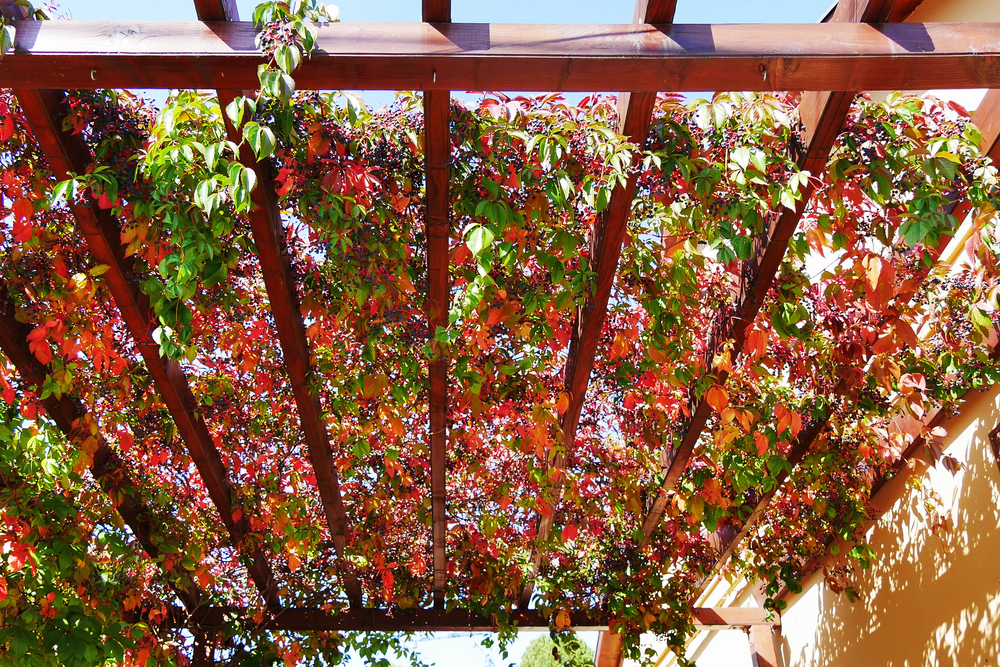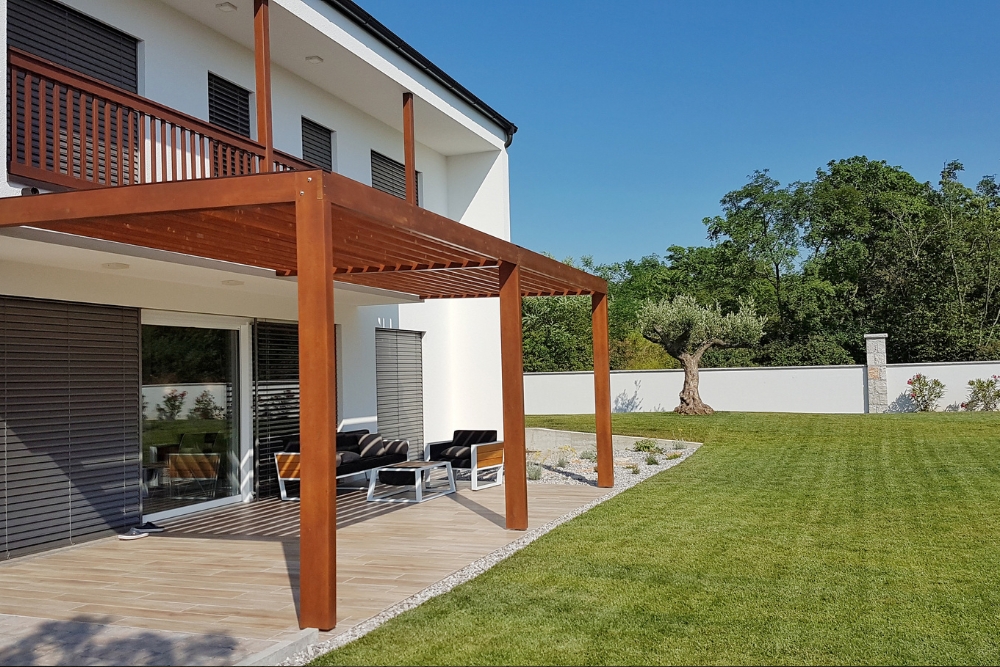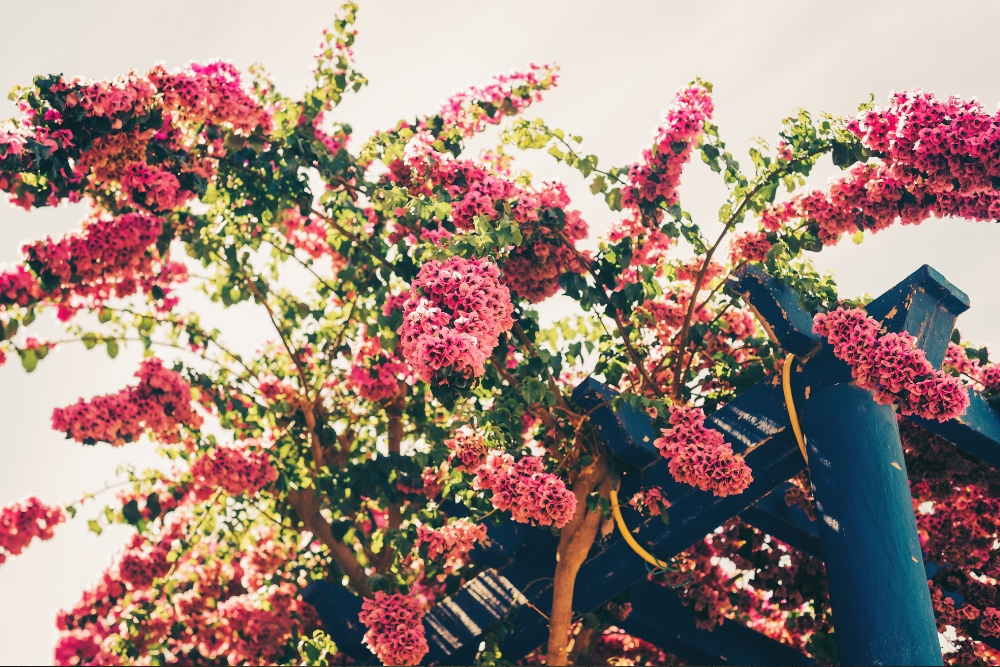When it comes to outdoor space enhancement, elegance and nature can flawlessly intertwine, resulting in spaces that are both charming and purposeful. One of the more traditional, yet evergreen, methods is to incorporate climbing plants into architectural features, resulting in a delightful dance of wood, metal, and greenery. A pergola offers a unique canvas for this purpose – its structure is perfect for clinging climbers, weaving a tapestry of greenery strung with flowers.
The outcome? A living ornament that meets the sky, a naturally shaded sanctuary, and a feature that transforms with seasons. This elegant infusion of climbing plants not only wraps your pergola in a verdant veil but also adds an irreplaceable character to your garden. Join us, as we guide you on how to weave this vine-covered wonder into your very own pergola design.
Key Takeaways
- Select vines for your pergola based on climate, growth habits, and sunlight requirements to ensure they thrive and create the desired effect. Aussie favourites include wisteria, jasmine, bougainvillea, and passionfruit.
- Prepare your pergola by ensuring it has a sturdy structure like a trellis to support the weight of growing plants which can also help guide their growth effectively.
- Maintain your climbing plants with regular pruning to manage overgrowth and keep them healthy. Look out for pests or diseases and treat them quickly to prevent damage.
- Enhance the look of your pergola with a mix of flowering and non-flowering vines for year-round interest. Consider adding lights like solar-powered string lights or LED uplighting to showcase the vines at night.
- Climbing plants not only improve the aesthetic appeal but also offer practical benefits such as natural shade and privacy while attracting wildlife like birds and butterflies into your garden.
Choosing the Right Vines and Climbers
Creating a luxurious canopy of green for your pergola is a blend of careful consideration and appropriate selection.
Consideration of vines and climbers should not be haphazard, but should factor in the specific climate of your location, the available sunlight in your outdoor space, and the overall aesthetic you desire to achieve. For Australian climates, certain vines have been proven to thrive better than others.
Recommended selections include the enchanting wisteria, known for its elegant draping blooms, the fragrant jasmine which releases a sweet aroma in the evenings, and the colourful bougainvillea, renowned for its vibrant and showy bracts.
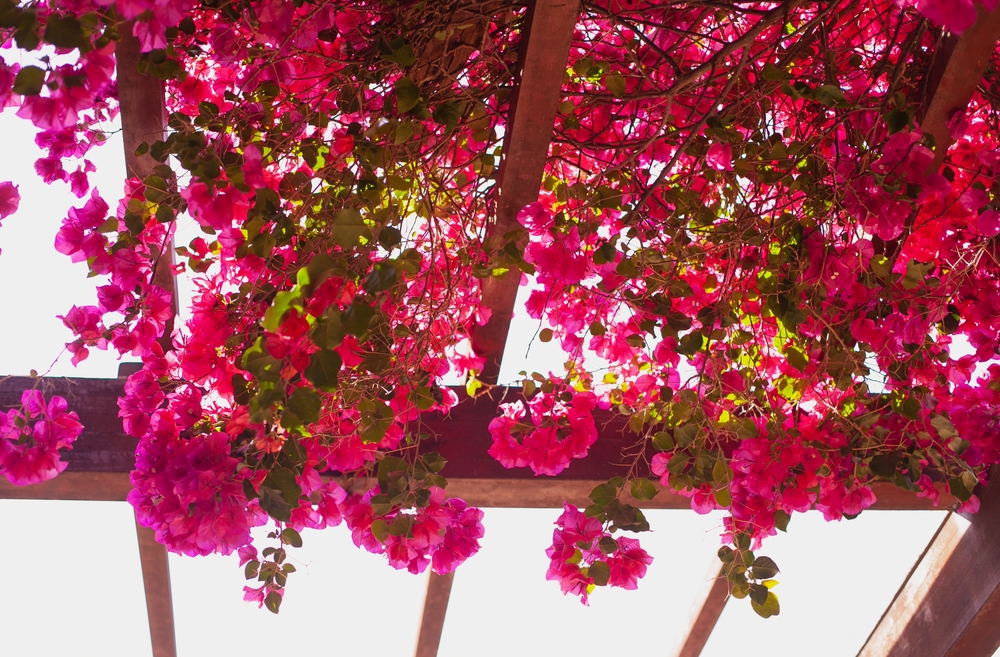
If you’d like to add a fruitful touch, passionfruit vines are a great choice, offering not only lush foliage but also an annual bounty of delicious fruits. These plants will not only ensure your pergola has year-round appeal, but they’ll also stay consistent with the beauty and challenges of Australian weather.
Factors to consider
- Climate compatibility: We check if the vine flourishes in our local climate. For those in Australia, native climbers like Pandorea and Hardenbergia are excellent choices as they’re adapted to the weather conditions.
- Growth habits: We select vines based on their growth speed and habit. If we desire quick cover, fast-growing vines like Star Jasmine are ideal. However, for more controlled growth, slower climbers like Ivy might suit better.
- Sunlight requirement: We assess the amount of sunlight our pergola receives. Shade-loving climbers such as Hydrangea petiolaris thrive in less sun, whereas sun-worshippers like Bougainvillea need plenty of rays to blossom.
- Maintenance needs: We opt for vines that match our commitment to upkeep. Some vines require frequent pruning to avoid overgrowth; others, like certain creeper plants, are lower maintenance.
- Structural impact: Before planting, we ensure the pergola can support the mature weight of the vine. Robust structures can support heavier options like Wisteria.
- Soil type and health: Just as important is checking soil quality. We amend it accordingly to promote healthy vine growth.
- Watering requirements: Our choice takes into account how much watering each species will need. Drought-tolerant varieties demand less frequent watering — a bonus during water-restrictive periods.
Recommended types of vines and climbing plants
When considering vines and climbers for your pergola, it’s essential to choose varieties that are well-suited to the Australian climate and the specific conditions of your outdoor space. To achieve the lush greenery and shade you desire, here are some recommended types of vines and climbers:
- Bougainvillea: Known for their vibrant bracts in shades of pink, purple, red, or orange, bougainvillea vines thrive in warm climates and can withstand periods of drought.
- Wisteria: With its cascading clusters of fragrant blooms in shades of blue, violet, or white, wisteria is a popular choice for creating a picturesque pergola canopy.
- Jasmine: Fragrant and delicate, jasmine vines offer both beauty and fragrance with their white or yellow blossoms.
- Climbing Roses: These classic ornamental climbers come in a variety of colours and provide not only visual appeal but also a touch of romance with their sweet scent.
- Clematis: Available in an array of colours, clematis vines add elegance to pergolas with their large, star-shaped blooms that bloom profusely during the growing season.
- Honeysuckle: With their sweetly scented flowers that attract pollinators such as hummingbirds and butterflies, honeysuckle vines create a charming ambience while offering privacy.
- Passionflower: Known for its exotic appearance and intricate flowers, passionflower vines make a unique addition to pergolas while attracting pollinators to your outdoor space.
Preparing Your Pergola for Climbing Plants
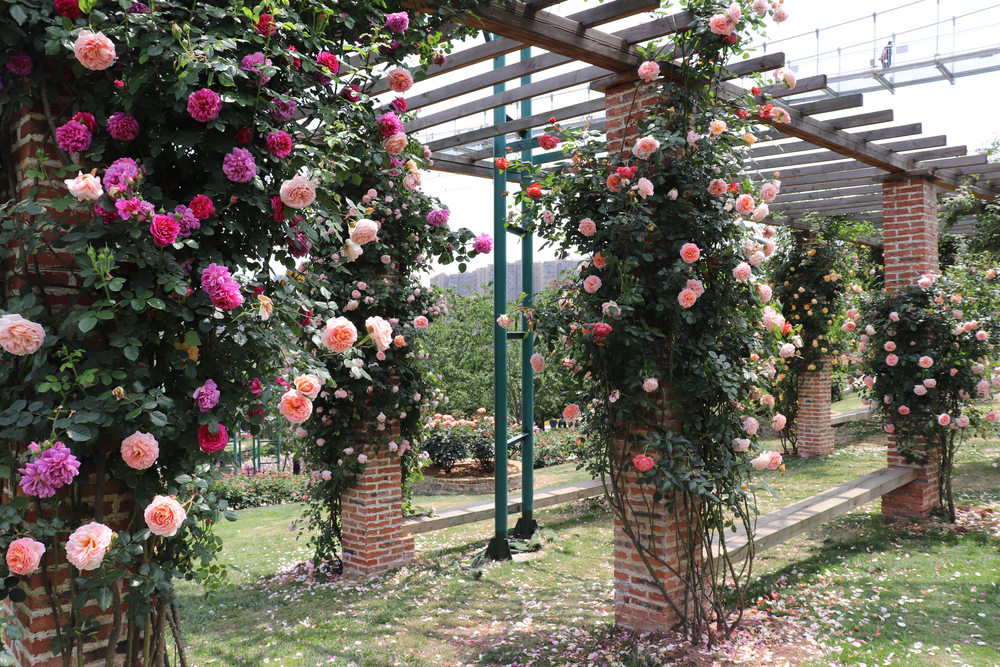
Before the first bud uncurls on your climbing plants, laying the groundwork for them to succeed is crucial and it starts with your pergola.
Making sure that your pergola is structurally sound is the first step as it should be strong enough to handle the weight of the plants, which can become considerable as they mature. The addition of reinforcements might be necessary depending on the type and quantity of plants you plan to host.
Next, consider creating a trellis or further support framework on your pergola for the vines to latch onto and climb.
This step encourages healthy growth and spread of your climbers, ensuring they distribute their weight evenly across the structure. With these preparations in place, your pergola is set to transition from a simple outdoor frame to a vibrant display of climbing plants, enhancing the allure of your outdoor space in no time.
Ensuring proper support
To ensure proper support for your climbing plants on the pergola, use sturdy materials such as metal wires or wooden lattice that can withstand the weight of the vines. Position these supports close enough to the pergola structure for easy attachment and growth guidance.
Incorporating anchor points along the pergola beams will provide additional stability and control over vine growth.
When securing your trellis or framework, make sure it is firmly attached to the pergola to prevent swaying in strong winds and other weather conditions. Regularly inspect the supports to check for any signs of wear and tear, ensuring that your climbing plants have a stable foundation to thrive on.
Creating a trellis or framework
To incorporate climbing plants into your pergola design, you can create a trellis or framework. Here are the steps to do so:
- Select sturdy materials such as timber or metal for the trellis or framework to ensure it provides ample support for the vines and climbers.
- Position the trellis or framework in a way that complements the design of your pergola and allows for optimal sunlight exposure for the climbing plants.
- Ensure that the trellis or framework is securely anchored to the ground or attached to the pergola structure to prevent movement and instability as the vines grow.
- Space the crossbars or wires evenly along the trellis or framework to provide ample places for the climbing plants to attach and grow, creating a luscious green canopy over your pergola.
- Consider incorporating decorative elements such as ornate designs, lighting fixtures, or hanging baskets within the trellis or framework to add visual interest and personality to your outdoor space.
Planting and Caring for Vines and Climbers
Raising vines and climbers on your pergola entails more than just planting them and letting nature have its way. It involves active participation from you, employing specific techniques for better growth.
Training is a fundamental method, guiding your vines and climbers directionally as they start their ascent on your pergola, ensuring they spread evenly and cover the entire structure as you desire. Additionally, regular maintenance plays a pivotal role in their care.
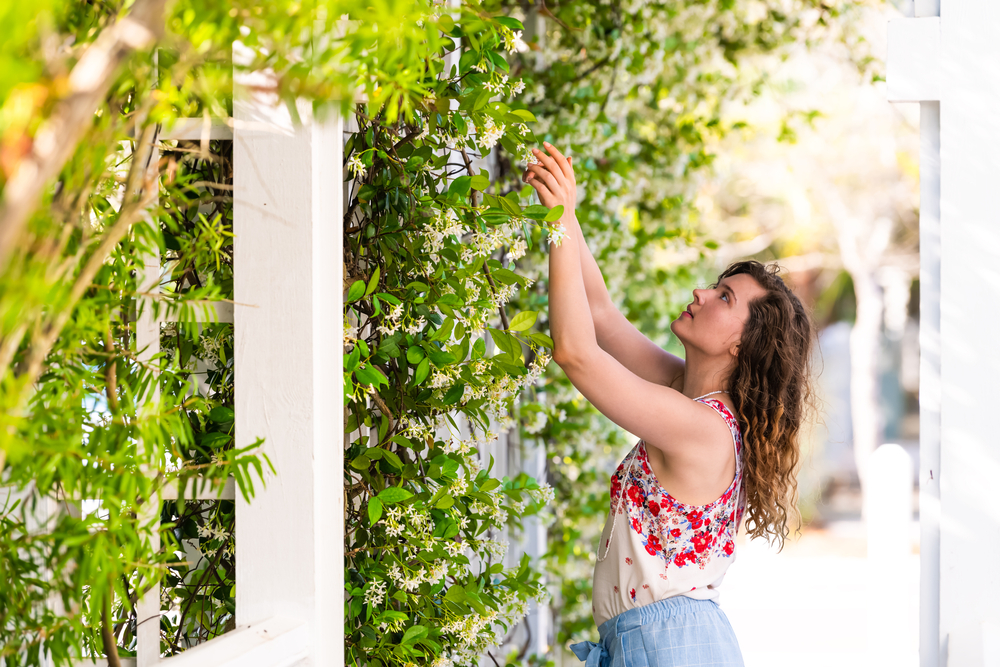
A common part of this is pruning, which not only helps maintain the shape and coverage but also encourages more vigorous and abundant growth. By keeping a keen eye on the growth patterns and regularly intervening to guide or manage the growth, you can keep your pergola looking lush, green, and healthy.
Techniques for training and guiding growth
To train and guide the growth of climbing plants on your pergola, follow these steps:
- Select the right support structure for your vines, such as trellises or wires, to guide as they grow.
- Gently tie the stems of the plants to the support structure using soft twine or plant ties, allowing them to climb upward.
- Regularly prune any unwanted growth and redirect the vines towards the desired areas of your pergola.
- Encourage the development of lateral branches by pinching off growing tips, promoting fuller coverage over time.
- Monitor the growth of your climbing plants and adjust their positioning as needed to maintain an appealing and balanced appearance.
Tips for maintenance and pruning
- Regularly inspect the vines for any signs of disease or pests, and address any issues promptly using organic treatments if possible.
- Prune dead or damaged growth to promote new healthy growth and maintain the overall shape of the vines.
- Avoid over-pruning, as this can stress the plants and inhibit their natural growth patterns.
- Use clean, sharp pruners to make precise cuts, minimising damage to the vines.
- When pruning, consider the specific needs of each type of vine, as different varieties may require different pruning techniques.
- As part of maintenance, regularly remove any debris or fallen leaves from the base of the vines to prevent moisture build-up and discourage pests.
Enhancing Your Pergola with Climbing Plants
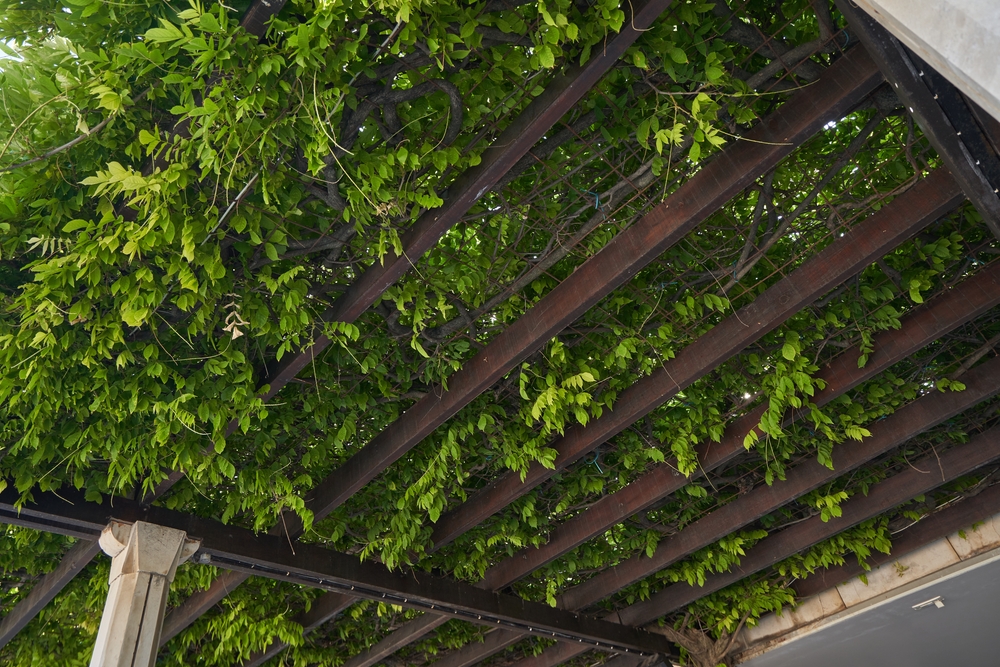
Taking the architectural appeal of your pergola to the next level by integrating climbing plants contributes significantly to enhancing your outdoor space. Tendrils of green weaving through the pergola structure and eventually culminating into a verdant canopy can introduce a living, breathing element of natural beauty.
This lush covering not only adds visual interest but also provides much-needed shade during hot summer days and an additional layer of privacy, effortlessly curating an outdoor retreat.
The beauty of this idea lies in its versatility and endless possibilities, be it a sea of emerald leaves or a vivid display of climbing blooms each season. With careful positioning of various types of vines, you can create layers of colours and textures. Adding strategic lighting can illuminate these details and highlight the architecture during evenings, creating an enchantingly inviting outdoor space – perfect for winding down after a long day or for entertaining guests amidst a captivating garden spectacle.
Benefits of incorporating greenery
Adding greenery to your pergola offers numerous benefits. Lush vines and climbers provide natural shade, keeping your outdoor space cool and comfortable during hot Australian summers.
They also create a vibrant atmosphere, enhancing the visual appeal of your pergola and blending it seamlessly with the surrounding landscape. By incorporating greenery, you can transform your pergola into a private oasis, attracting native wildlife such as birds and butterflies while promoting biodiversity in your backyard.
Integrating climbing plants into your pergola design not only elevates the aesthetic charm of your outdoor space but also contributes to a healthier environment. The presence of vegetation helps purify the air by absorbing carbon dioxide and releasing oxygen while reducing pollutants.
Moreover, greenery fosters a sense of tranquillity, offering you a peaceful retreat amidst nature’s beauty right in the comfort of your backyard.
Ideas for placement and variety
Enhancing your pergola with climbing plants not only adds greenery and shade but also brings a touch of natural elegance to your outdoor space. Here are some ideas for placement and variety to help you make the most of your pergola:
- Choose a mix of flowering and non-flowering vines to create visual interest throughout the seasons.
- Train fast-growing vines along the top of the pergola to form a lush canopy for maximum shade.
- Use fragrant climbing plants near seating areas to add a pleasant aroma to your outdoor space without overpowering it.
- Combine different vine varieties with varying leaf shapes and textures to create a dynamic, layered look.
- Incorporate trailing or cascading vines at the edges of the pergola for a soft, natural transition between structure and garden.
Lighting options to highlight the vines
After considering the ideas for placement and variety, it’s essential to explore lighting options that will beautifully highlight the vines on your pergola. Here are some effective ways to achieve this:
- Solar-Powered String Lights: These eco-friendly lights create a warm ambience and can be easily draped along the trellis or framework, accentuating the vines and adding a touch of magic to your outdoor space.
- Spotlights: Position spotlights strategically around the base of the pergola to cast a gentle glow upward, showcasing the lush greenery as it climbs and intertwines with the structure.
- LED Uplighting: Install discreet LED lights at ground level, pointing upwards to illuminate the vines from below, creating a dramatic effect that enhances their natural beauty.
- Fairy Lights in Jars: For a whimsical touch, place battery-operated fairy lights inside hanging jars among your vines – providing a charming and enchanting glow after sunset.
Call Us!
By incorporating climbing plants, you can significantly enhance your outdoor space, adding charm and natural beauty to your property. For further inspiration or guidance, consider exploring local nurseries or seeking professional landscaping services.
Let’s transform our pergolas into enchanting havens with lush greenery and fragrant blooms!

